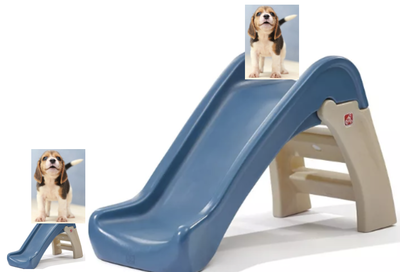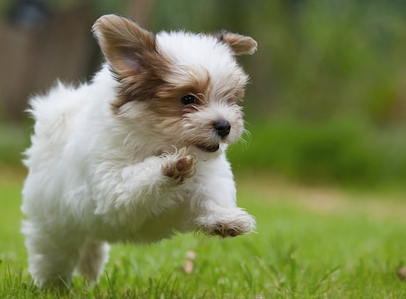When you choose breeding dogs based on hip (or elbow) scores, you are assuming that a good score reflects "good" genes. But we know the heritability of hip dysplasia is relatively low. When you compare the scores of multiple dogs, only about 20% of the variation in scores reflects variation in the genetics of the dogs. Or, to put it another way, 80% of the variation among the dogs you are evaluating is a consequence of non-genetic factors, about which you know nothing. When you eliminate a dog for a low hip score, it is likely that the score reflects some environmental factor and NOT genetics. Wow. No wonder generations of selection hasn't moved the needle much towards better hips in dogs.
But again and again, I see puppies in situations that can have a HUGE effect on the risk of developing hip dysplasia. It seems obvious to me, but it must not be to others judging by how common it is. I will try to describe it here in a way that should stick in your mind when you provide experiences for your next litter of puppies.
Toddler Safety
Look at this photo. It depicts a toddler standing on a small table and also standing on a large table.
If this is your todder, one of these images will spur you into action to whip that kid off the table before he falls off or tries to jump. It's that large table, right? Why? Because the distance that toddler would fall is likely to result in injury. The small table isn't so worrisome. The child could crawl off or step down carefully. Even if the child jumps for falls, the distance to the floor is short and not likely to result in more than tears. But a toddler falling from the large table could do some serious bodily damage.
What About Eggs?
You've probably seen those high school students learning a bit about physics in an egg dropping contest. The goal is to drop an egg from a particular height without it breaking. Close to the ground, it's easy. But as the egg is dropped from greater heights, the accidents start to happen. Everything stays the same except the distance the egg falls, but the farther it falls the greater the force of landing. If the students don't come up with a clever way to protect the eggs from the force of impact, their egg will be a fatality.
This is just like the toddler on the table. The toddler's skeleton, muscles, and ligaments can accommodate the force of a short fall. But from greater heights, the force of impact will also be greater and at some point will exceed the limitations of the body. Parents see the danger intuitively and make sure their kids play in the part of the playground designed for the little folk where there are no opportunities to fall far enough to do damage.
What About Puppies?
Puppies are toddlers. Not very big, not very strong, not very coordinated, and not even fully developed. In particular, the joints are cartilage instead of bone. They are not designed to tolerate extreme forces of impact or stress, and they will not be fully ossified until the puppy is about 6 months old. For the first few months of the puppy's life, the joints are designed to tolerate "normal" forces a puppy would experience while running and playing.
The most common cause of cartilage damage in children is from trauma. Sports, accidents, and activities that can result in impact are obvious risk factors for children. The same factors also apply to puppies.
Let's replace the toddler on the table with a puppy at similar scale. The puppy on the small table can get down without doing major damage because the height is low - the puppy could just step down - and even if it jumps, the potential force of impact will be small. Most people would see the puppy on the large table at risk of serious injury if it falls or jumps and would snatch it into the arms of safety immediately. Good instincts.
How to Break Puppy Hips and Elbows
If you were among those that would rescue the little puppy from the large table in the picture above, good job! I think most people would.
If you wouldn't allow a puppy to play on a high table, would you allow a puppy to play on some other object that provides a similar risk of a traumatic fall?
So often I see photos of baby puppies, four or five weeks old - very much at the toddler stage - with all sorts of colorful, fun-looking jungle-gym type toys to play on. Perhaps the bright colors, or the perception that these are "fun" things that we enjoyed as children, somehow fails to trigger the parental "danger" instinct. Yet the risk is not different. The expectation is that the puppy will slide down and be deposited safely on the ground at the bottom. But puppies more often fall over the side of the slide, get ejected some distance at the bottom, or worse turn around and simply jump off the side with the steps - which they could not step down as a toddler would.
If you had to create an apparatus designed to break hips and elbows, this could be a winner.
Look at the skeleton of a dog. When the feet hit the ground, the force of impact is transmitted up the legs to the joints. There are two critical leg joints that are not designed to absorb shock - the hip, which is a ball-and-socket joint, and the elbow, which involves the complex articulation of several bones to allow the leg to move forward and aft. Hips and elbows of adult dogs are designed to survive the trauma of reasonable impact at these joints. The hips and elbows of young puppies are not.
Safely Falling Puppies
Browse through the photos below. All of these puppies are falling.
The running puppy launches itself into the air with the force of the back legs, and the shoulder apparatus absorbs the force of the fall when it lands. The maximum height of that fall is a bit more than the length of the legs, which is usually about half the height of the puppy at the withers. The normal structural features of a puppy should be able to tolerate a fall of this height.
A puppy should be able to jump off something that's about the height of the puppy at the withers, because that's about how far the puppy falls when running. But even if it jumps, the force of landing should be within the design limits of the puppy support structures.
Those Cute, Fat Puppies
We love roly-poly puppies. But at what price?
Look at the photos of running puppies. The force of the landing at the end of each stride will be greater for a fat puppy than a lean one. Puppies run a lot, so even a modestly overweight puppy will experience an abnormal landing force with every stride, over and over and over. Like hammering a nail with a hammer, one hard pound might get the nail through the board, but gentle, repetitive pounding will also eventually drive the nail through a board.
In a puppy, a little extra weight is multiplied many times in terms of trauma to the structures of a joint. Trying to select against hip dysplasia through careful evaluation of hip scores of adults is a waste of time if the forces on the hip joint of the puppy are greater than the joint is designed to tolerate. If you want healthy hips and elbows in your adult dogs, keep them lean as puppies.
| Puppies And Stairs No, puppies are not stuck at the top of the stairs because they don't know how to come down. They look over the top of the first stair, and their little puppy brain screams DANGER DANGER DANGER! You know the feeling when you look over the edge of a cliff? That's what is happening in that puppy. Go to YouTube and check out the videos of puppies falling down stairs. Here is one representative compilation titled "Puppies going down stairs for the first time compilation - WARNING: CUTE" Not cute. www.youtube.com/watch?v=EkM8ZkMgRXo |
Pay Attention to the Environment
If we want to produce dogs with better hips, we can make the biggest difference most quickly by paying attention to the environmental factors that can increase the risk of developing dysplastic hips and elbows. Health and welfare of our dogs should be our highest concerns, and we can considerably reduce orthopedic pain and suffering by eliminating environmental sources of risk whenever we can.
Put the jungle gym equipment in the garage or donate to the local preschool. Let your puppies have a good time and experience lots of new things, but keep the feet on the ground or no higher than the puppy would "fall" from when running. Try to look at the world from the viewpoint of a puppy - maybe 10 inches high and a few pounds, and just learning how to control those legs.
Genetics matter, but the possibilities of improving hips and elbows are much greater if we can mitigate the sources of that 80% of variation in hip scores that is not accounted for by genes.
ICB's online courses
***************************************
Visit our Facebook Groups
ICB Institute of Canine Biology
...the latest canine news and research
ICB Breeding for the Future
...the science of animal breeding














